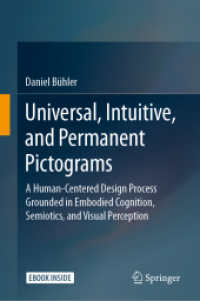基本説明
This book presents a comprehensive portrait of the Kitab Sabawayhi. It offers new insights into its historical and linguistic arguments and underlines their strong correlation.
Full Description
This book presents a comprehensive portrait of the Kitāb Sībawayhi. It offers new insights into its historical and linguistic arguments and underlines their strong correlation. The decisive historical argument highlights al-Ḥīra's role, not only as the centre of pre-Islamic Arabic culture, but also as the matrix within which early Arab linguistics grew and developed. The Kitāb's value as a communicative grammar forms the crux of the linguistic argument. The complementarity of syntax and pragmatics is established as a condition sine qua non for Sībawayhi's analysis of language. The benefits of a complementary approach are reflected in the analysis of nominal sentences and related notions of ibtidā' and definiteness. The pragmatic principle of identifiability is uncovered as the ultimate determiner of word order.
Contents
CONTENTS
Acknowledgements ............................................................................ ix
Preface .................................................................................................. xi
Chapter One Historical Background ........................................... 1
1. Life .................................................................................................. 4
2. Cultural and Social Milieu .......................................................... 7
2.1. Al-Ḥīra: a Synoptic View .................................................... 7
2.2. Population ............................................................................. 11
2.3. Cultural history .................................................................... 15
2.4. Kūfa-Basṛ a Dichotomy ........................................................ 19
2.5. The Naḥwiyyūn .................................................................... 22
3. The Kitāb ....................................................................................... 27
3.1. Sources of the Kitāb ............................................................ 30
3.1.1. Qurʾān ......................................................................... 30
3.1.2. Ḥadīt ̠ (Prophetic Tradition) ................................... 33
3.1.3. Poetry ......................................................................... 34
3.2. Status of the Kitāb ................................................................ 35
3.2.1. Arab Grammarians .................................................. 37
3.2.1.1. az-Zajjājī (d. 337/949) ............................... 38
3.2.1.2. as-Sīrāfī (d. 368/979) ................................. 39
3.2.1.3. ar-Rummānī (d. 384/994) ......................... 39
3.2.1.4. Ibn Jinnī (d. 392/1002) ............................. 39
3.2.1.5. Ibn al-ʾAnbārī (d. 577/1181) .................... 40
3.2.1.6. Ibn Hišām (d. 761/1360) .......................... 40
3.2.2. Western Scholars ...................................................... 40
Summary ............................................................................................. 44
Chapter Two Complementarity .................................................... 47
1. Utterance Tuning Parameters ..................................................... 49
2. Complementarism ........................................................................ 55
2.1. Communication act as an event ........................................ 61
2.2. Istiqāma, Grammaticality and the Speaker's Intention ... 74
2.3. Negotiability and Motivation ............................................. 79
2.3.1. Negotiability in Sībawayhi ...................................... 81
2.3.2. Motivated Use of Case Endings ............................. 82
2.3.3. Motivated Reduction ............................................... 84
2.4. Conventionality .................................................................... 88
2.4.1. Absolute Conventionality ....................................... 89
2.4.2. Motivated Conventionality ..................................... 91
Summary ............................................................................................. 94
Chapter Three Definiteness and Identifiability .......................... 95
1. Preliminary Observations ........................................................... 96
2. Definiteness in the Kitāb ............................................................. 99
2.1. Criteria of Adjectival Qualifiability .................................. 104
2.2. Proper Nouns ....................................................................... 108
2.3. Hierarchy of Definiteness ................................................... 117
3. Definiteness and Non-Arbitrariness of Word Order .............. 123
3.1. Word Order in Arabic Nominal Sentences ..................... 125
3.1.1. Indefinite Nouns and the Initial Position ............ 130
3.1.2. Kāna and its Sisters 'Kāna wa 'Aḫawātuhā' .......... 136
3.2. Verbs and the Initial Position ............................................ 143
Summary ............................................................................................. 148
Chapter Four Mubtadaʾ, Topic and Theme ................................ 151
1. Introductory Remarks ................................................................. 152
2. Three Structural-Functional Theories ....................................... 157
2.1. Dik's Functional Grammar ................................................. 157
2.2. Information Structure and Role and Reference
Grammar ............................................................................... 160
2.3. Systemic Functional Grammar .......................................... 164
2.3.1. Downing's view on Topic, Theme and the 'Initial'
Position ...................................................................... 167
2.3.2. Participant's Role in Identifying Topics ................ 171
3. Mubtadaʾ and Ibtidāʾ: an Alternative Approach to an Old
Problem .......................................................................................... 178
3.1. Inverted Nominal Sentence and Types of Ḫabars .......... 183
3.2. Reversibility of the Three Types of Ḫabars ..................... 191
3.3. ʾInna and its Related Particles ........................................... 193
Summary ............................................................................................. 200
Chapter Five Conclusion ............................................................... 203
Bibliography ........................................................................................ 217
Index .................................................................................................... 229







